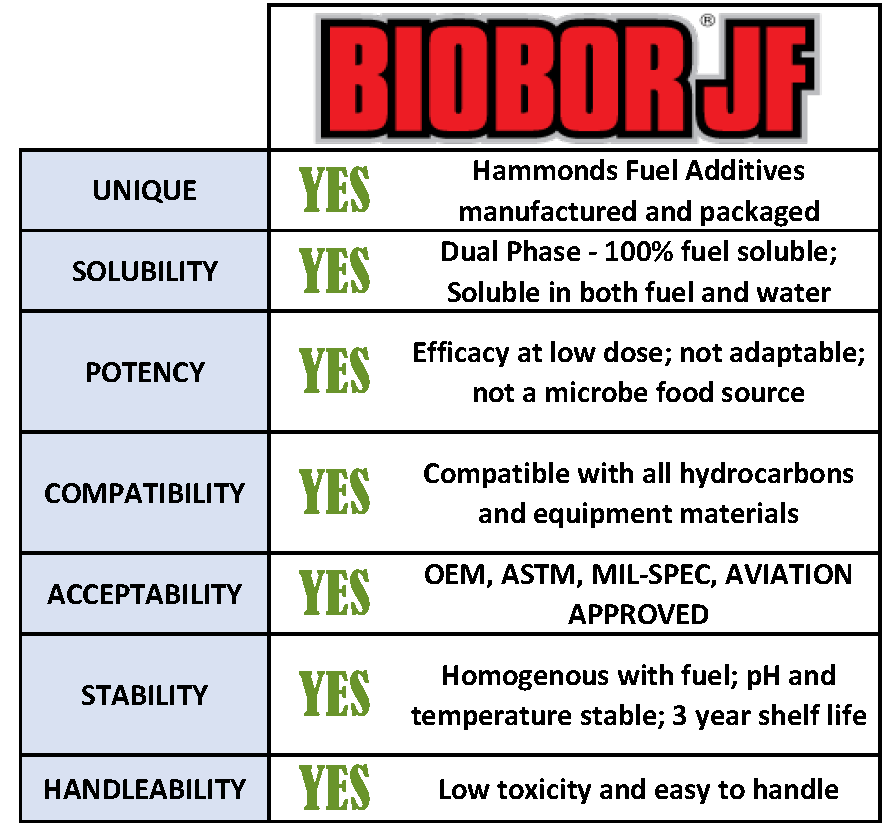Biobor JF is the Answer
Our last post investigated the challenges with finding the problem in your tank. This post will answer the question, “How do I treat the problem in my tank?” The simple answer is apply a biocide. However, there really never is a simple answer when it comes to properly treating fuel and fuel systems. Microbial contaminants are diverse and more complicated than most would like to admit. This complication lends itself to the a host of other questions that need to be answered.
The Questions about Treating Your Fuel Tank with a Biocide
- What are the attributes of a good biocide?
- When should I apply a biocide?
- How do I properly apply a biocide?
- What happens after I treat with a biocide?
What are the attributes of a good biocide?
We wrote about the “ideal biocide” and continue to help others understand the importance of choosing the right biocide. In the post, we point out that there are six attributes to an ideal biocide: (1) solubility (2) potency (3) compatibility (4) acceptability (5) stability and (6) handleability – low toxicity. Here is a quick overview. A biocide must be dual phase, possessing complete fuel solubility and high water solubility. Biobor JF is miscible (100% soluble) in fuel and has excellent water solubility, designed to stay in the fuel until and partition into water when found.

A biocide must be potent, able to kill microbes without adaptation or becoming a food source for the microbe. A biocide must be compatible with the fuel and fuel system equipment. Biobor JF has been proven time and again to possess this attribute. A biocide must be acceptable. Biobor JF has earned an exhaustive list of recommendations, approvals and certifications that continues to grow. A biocide must be stable. Temperature and pH are two variables that prove to be failing points with many biocides. Biobor JF is both temperature and pH stable. A biocide must have low toxicity to humans and the environment. Biobor JF exhibits this quality. For more details check out our prior post, The Ideal Fuel Biocide.
When should I apply a biocide?
This is an easy answer. As soon as you have identified a problem, apply the biocide. Don’t wait for it to get worse, because it will. If fuel testing is not definitive or shows a negligible amount of microbial contamination and you have corrosion issues or other attributing operational issues described in our prior post, apply Biobor JF. The sooner you take action, the less likely you are to have ongoing problems.
How do I properly apply a biocide?
In order for a biocide to work efficiently, it should be applied in such a way as to allow fast coverage of the fuel. That means it should be mixed or blended. The question sometimes comes up, “What if I don’t have a way to properly blend the biocide?” My answer is, “Make sure you only use Biobor JF because no other fuel biocide is equal in solubility and no other biocide can adequately dissolve into the fuel to be effective.” There are several ways to accomplish proper blending.
Ways to blend a biocide into fuel
- Apply Biobor JF before a fuel drop is made. Splash blending prior to a fuel drop provides enough agitation to get the job done.
- Use a pump to circulate the fuel and biocide together. This is often done during water pump outs and filtration.
- Inject the biocide into the fuel using and injection system. Check out Hammonds Technical Services’ additive injection systems.
One aspect of properly applying a biocide is soak time. Giving the biocide enough time to kill the microbes is vital. If high levels of microbial contamination is indicated, then consider longer soak times.
What happens after I treat with a biocide?
You will certainly have dead bugs and likely have biomass floating around. So a dirty tank should be cleaned. Fuel and tank cleaning provides a fresh start for your fuel system. We will discuss this in greater detail in a later post. Just know that you need to get the junk out. You might ask, “Is there anything else that needs to be done?” Yes there is, consider a regular maintenance dose of Biobor JF to keep your system clean. Our research shows that a quarterly maintenance treatment of Biobor JF will help to keep your system clean and reduce costs associated with microbial contamination along the way. In the next post, we will talk about other additives that can be used to remediate fuel.

Share the Post








